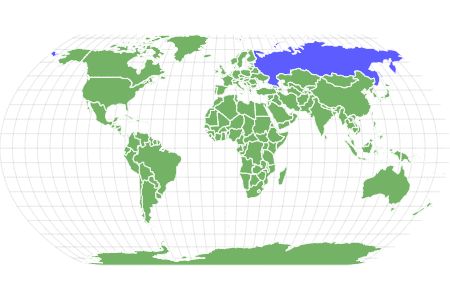Black Russian Terriers, or blackies, were bred in the former USSR to be a working dog for the army.
Advertisement
Black Russian Terrier Scientific Classification
- Kingdom
- Animalia
- Phylum
- Chordata
- Class
- Mammalia
- Order
- Carnivora
- Family
- Canidae
- Genus
- Canis
- Scientific Name
- Canis Lupus
Read our Complete Guide to Classification of Animals.
Black Russian Terrier Conservation Status
Black Russian Terrier Facts
- Fun Fact
- Black Russian Terriers, or blackies, were bred in the former USSR to be a working dog for the army.
- Temperament
- Brave, confident and courageous
- Training
- Should be trained from an early age as they will become dominant
- Diet
- Omnivore
- Average Litter Size
- 5
- Common Name
- Black Russian Terrier
- Slogan
- Confident, calm and highly intelligent!
- Group
- Terrier
Black Russian Terrier as a Pet:
- General Health
- Energy Level
- Shedability
- Trainability
- Intelligence
- Tendency to Chew
- Size
- Family and kid friendliness
- Yappiness / Barking
- Moderate
- Separation Anxiety
- High
- Preferred Temperature
- Average climate
- Exercise Needs
- Moderate
- Friendly With Other Dogs
- Moderate
- Pure bred cost to own
- $1,800-$2,500
- Dog group
- Working
- Male weight
- 80-130 lbs
- Female weight
- 80-130 lbs
This post may contain affiliate links to our partners like Chewy, Amazon, and others. Purchasing through these helps us further the A-Z Animals mission to educate about the world's species.
View all of the Black Russian Terrier images!
Black Russian Terriers, or blackies, were bred in the former USSR to be a working dog for the army. A mix of about 17 different breeds went into creating this large, black dog.
Some of the breeds used to create the Black Russian Terrier breed include Rottweilers, Giant Schnauzers, Airedale Terriers, and Newfoundlands. Black Russian Terriers worked to patrol the border or keep watch over prisoners.
See all of our expert product reviews.
In the 1950s, the Russian Army did not need as many Black Russian Terriers and allowed officers to bring their companions home and began selling Black Russian Terriers to civilians. The people of Russia soon learned what an intelligent, calm, and affectionate dog a blackie can be. Black Russian Terriers make great companions and guardians. Their personality traits also make them a good fit for homes with children.

Owning a Black Russian Terrier: 3 Pros and Cons
| Pros! | Cons! |
| Family-friendly Blackies can make an excellent family pet. They are playful, protective and loving. | Needs a lot of attention Blackies love getting attention from their family members. However, if they don’t get enough attention or are left alone for too long, they can develop separation anxiety or may become destructive. |
| Good guard dog Black Russian Terriers are very alert and protective. They are more suspicious of strangers or other dogs and will bark to alert their owners when something seems off. | Higher maintenance Black Russian Terriers need more grooming and trimming than many other breeds. Their coat will need to be brushed multiple times a week, and you will need to trim their hairs on their face or hire a professional groomer. |
| Loyal Blackies are very loyal and develop a strong bond with their owners. | Need physical and mental stimulation Black Russian Terriers will need both mental and physical stimulation. If you aren’t able to provide both of these on a daily basis, this may not be the right breed for you. |

©Csanad Kiss/Shutterstock.com
History and Origins
In the 1930s, the Soviet government established the Red Star Kennel near Moscow with the intention of creating a super-dog for the Russian army. This goal was difficult to achieve due to the destruction caused by the Russian Revolution and two world wars, which significantly reduced the quality of Russia’s purebred dog breeds. Because of the economic depression, importing high-quality dogs from other European countries was also close to impossible, so the team at Red Star had to start from scratch.
Seventeen breeds, including Airedale terriers, giant schnauzers, and rottweilers, were combined to create the Black Russian Terrier. After World War II, the program was enhanced with the introduction of high-quality dogs from Germany.
The Black Russian Terrier was bred to be a dedicated and tireless guard dog who could patrol the extensive borders of Russia. It was strong enough to capture and hold intruders at Stalin’s notorious prison camps, and its thick coat enabled it to work in even the coldest of temperatures. Despite its name, the breed contains less than 30 percent terriers.
Health and Entertainment for your Black Russian Terrier
- The Best Wet Food for Senior Dogs
- The Best Dog Food for Labrador Retrievers (Senior, Puppy, and Adult)
- These Are the Best Probiotics for Dogs (They Actually Work)
- Victor Senior Healthy Weight Dog Food Review: Recalls, Pros, Cons, and More
- The Best Dog Food for Small Dogs (Puppy, Adult, Senior): Ranked and Reviewed
See all of our expert product reviews.
The black Russian terrier was originally used by the army to guard important places like prisons, borders, and military camps. In the mid-1950s, when these places no longer needed protection, the army began selling the extra puppies to hobbyists and dog show enthusiasts. Retired officers who took their K-9 partners home in the late ’50s made the Russian people aware of this loyal guardian, which they fondly named the “Black Pearl of Russia” or simply “Blackie”.
The Black Russian Terrier is no longer used for guarding political prisoners but instead can be found on suburban lawns. It was recognized as a breed in 1981 by the Soviet Ministry of Agriculture and was accepted into the American Kennel Club’s Stud Book in 2004.
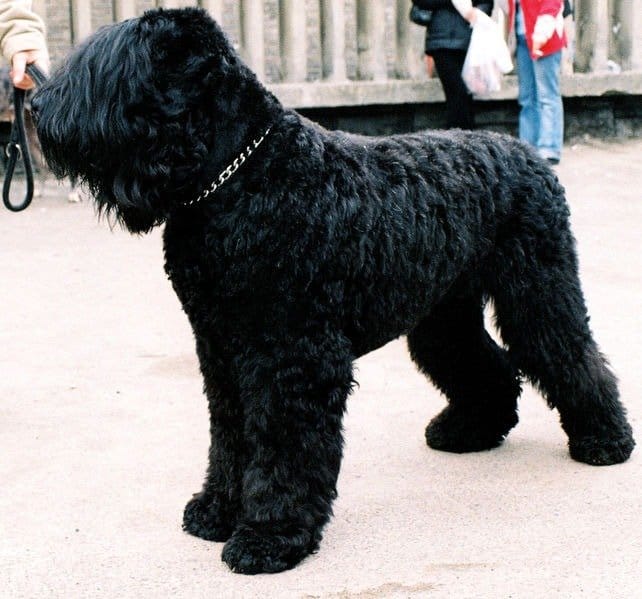
Black Russian Terriers were originally bred as guard dogs.
©Pleple2000, CC BY-SA 3.0, via Wikimedia Commons – License
Size and Weight
Black Russian Terriers are large terriers. Both males and females generally weigh between 80 and 130 pounds. Males may be a little taller, with a height between 27 and 30 inches, whereas females stand between 26 and 29 inches tall. Black Russian Terrier Puppies weigh between 24 and 36 pounds when they are three months old. By the time they are six months old, they will have grown to weigh between 64 and 78 pounds. They will be fully grown around the time they are 12 months old.
| Height | Weight | |
| Male | 27 inches to 30 inches | 80 pounds to 130 pounds |
| Female | 26 inches to 29 inches | 80 pounds to 130 pounds |

Black Russian Terriers are large dogs weighing between 80-130 pounds.
©Thomas & Dianne Jones (FreeWine) / CC BY 2.0, Flickr – License
Common Health Issues
In general, Black Russian Terriers are a healthy breed. However, there are still a few health issues you should be aware of that may impact your dog.
One issue to be aware of is hip dysplasia. This is a genetic condition where the thigh bone doesn’t connect correctly with the hip bones. It causes the two bones to rub against one another. This can be quite painful and may cause a blackie to limp. They can develop arthritis with age and will likely be very uncomfortable. Since this condition is genetic, if a blackie has hip dysplasia, they should not be bred.
Elbow dysplasia is another condition to be aware of with Black Russian Terriers. Like hip dysplasia, this condition is likely caused when the bones and joints don’t grow and develop properly. This leads to a weakened joint. Blackies with elbow dysplasia may develop arthritis. Surgery, medication, or weight-management measures may be recommended by a vet to treat elbow dysplasia.
Black Russian Terriers may also suffer from Progressive Retinal Atrophy or PRA. With this condition, the retina gradually deteriorates. Dogs will become night-blind at first but will eventually lose all eyesight.
To recap, three common health concerns for Black Russian Terriers include:
- Hip dysplasia
- Elbow dysplasia
- Progressive Retinal Atrophy (PRA)

Black Russian Terriers are prone to hip and elbow dysplasia.
©Jurriaan Schulman, CC BY-SA 3.0, via Wikimedia Commons – License
Temperament and Behavior
Black Russian Terriers are very confident and intelligent. These traits make them excellent guard dogs. However, their personality also makes them a good fit for families with children. They can make a great playmate for a child.
The breed enjoys spending time with members of the family. They love getting attention, but if they don’t get enough attention and are left home alone, this breed can also develop separation anxiety. Also, if left alone for too long, blackies may engage in destructive behaviors.
Proper socialization is important with these dogs. It will help them develop a more even temperament and make them more tolerant of people and other pets.
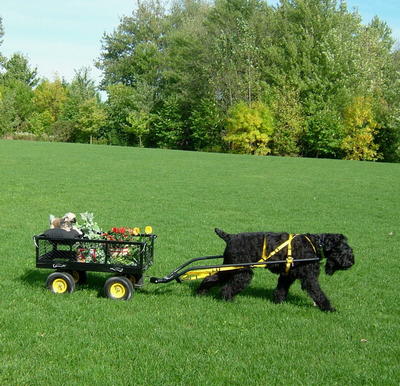
A Black Russian Terrier makes a great family companion.
©Flickr user dutchmasterdutchie, CC BY 2.0, via Wikimedia Commons – License
How to Take Care of a Black Russian Terrier
A Black Russian Terrier, though most likely a relatively healthy dog, will need special care tailored to their nutritional needs, temperament, health concerns, and the other unique features of this breed. For example, seek out the specific nutrients that help prevent bad eyes, hips, and joints in dogs.
The Best Dog Food
As a large dog, this breed will eat a lot of food each day. They typically eat 3-4.5 cups of food a day. The exact amount that your blackie will need will vary based on weight, age, activity level, and health concerns. If you aren’t sure how much food your blackie should be consuming, check with your veterinarian. Making sure your dog is getting the right amount of food is important for preventing obesity, which can lead to other problems like hip and elbow dysplasia.
Most dogs of this breed do best when their food is split into two smaller meals a day rather than one large meal. This can also help reduce the risk of bloat. Always look for high-quality foods from reputable manufacturers. You should select a large breed of food for adults and puppies alike.
Puppies have smaller stomachs and will need to be fed smaller, more frequent meals throughout the day. Young puppies should be fed four times a day. After a few months, you can drop it down to feeding them only three times a day. Then after a few more months, they should be fine eating two times a day.
At A-Z Animals, we think the best dog food for Black Russian Terriers is .
This premium, natural dog food made with chicken and pork has taurine, which is good for their eyes and vision since Black Russian Terriers can problems with their retinas. Additionally, the glucosamine in this recipe is a nutrient that’s proven to strengthen dogs’ joints.
See if your dog enjoys Holistic Select Natural Large and Giant Breed Dog Food, available on amazon.
Maintenance and Grooming
This breed has higher grooming needs than some other breeds. They have a double coat with a thick undercoat and a coarse outer coat. You will need to brush their coat at least once, if not more, every week. Additionally, the hairs around their face can grow long and make the dog look shaggy. They will either need to be trimmed by a professional groomer or trimmed by their owner periodically.
This breed is not known for heavy shedding, but they will shed some hair around the house if they aren’t brushed regularly. While they are not a heavy shedding breed, they are not hypoallergenic dogs. So, they are not a good option for homes with people who suffer from allergies.
In addition to brushing and grooming your dog’s fur, you will also need to brush their teeth a few times every week to prevent plaque and tartar from building up. Their nails will also need to be trimmed regularly. If the nails get too long, they can make it painful for a blackie to walk.
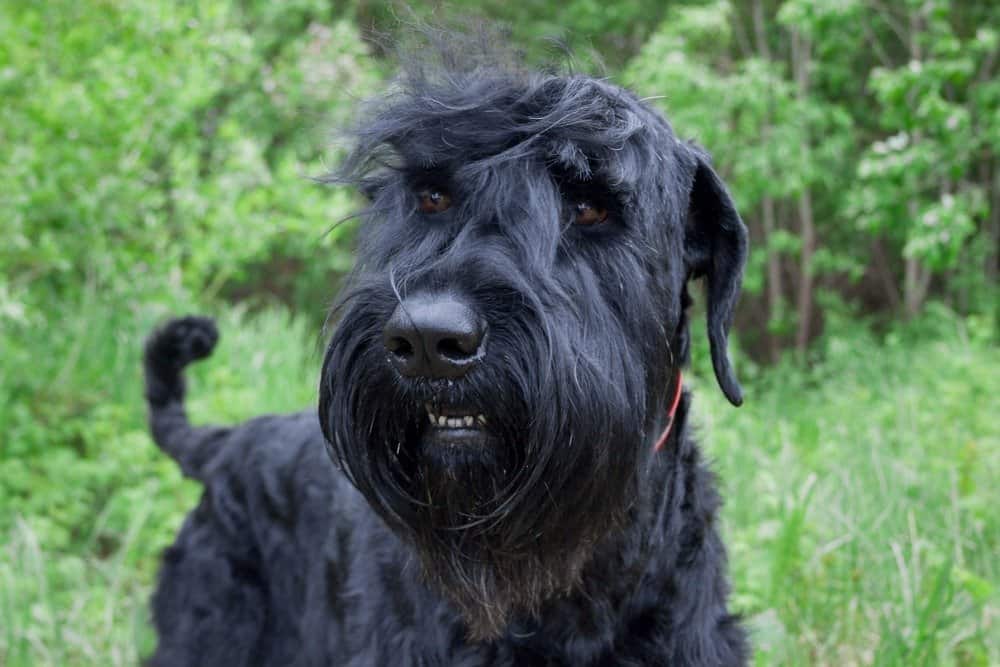
When it comes to grooming, Black Russian Terriers are high-maintenance.
©Tikhomirov Sergey/Shutterstock.com
Training
This breed is relatively easy to train. Training is essential, though. They are very large dogs, and without consistent, positive reinforcement-based training, they can be quite unruly and may become aggressive. They do learn quickly because of their higher intelligence, so with consistency, your blackie should pick up on commands and appropriate behaviors relatively easily.
In addition to training your dog from an early age, socializing them is also important. Socialization will help a Black Russian Terrier know how to act in different situations and around different people and pets.

Black Russian Terriers respond best to positive reinforcement training.
©Brezhneva.od/Shutterstock.com
Exercise
It will be important to keep your Black Russian Terrier active both physically and mentally. They are not a high-energy dog breed, so they don’t need as much physical exercise as some other breeds. Giving your dog about 45 minutes of exercise each day is generally sufficient. Walking, jogging, and vigorous playtime are all good options. Getting your dog involved in canine sports can help give them more mental stimulation as well.
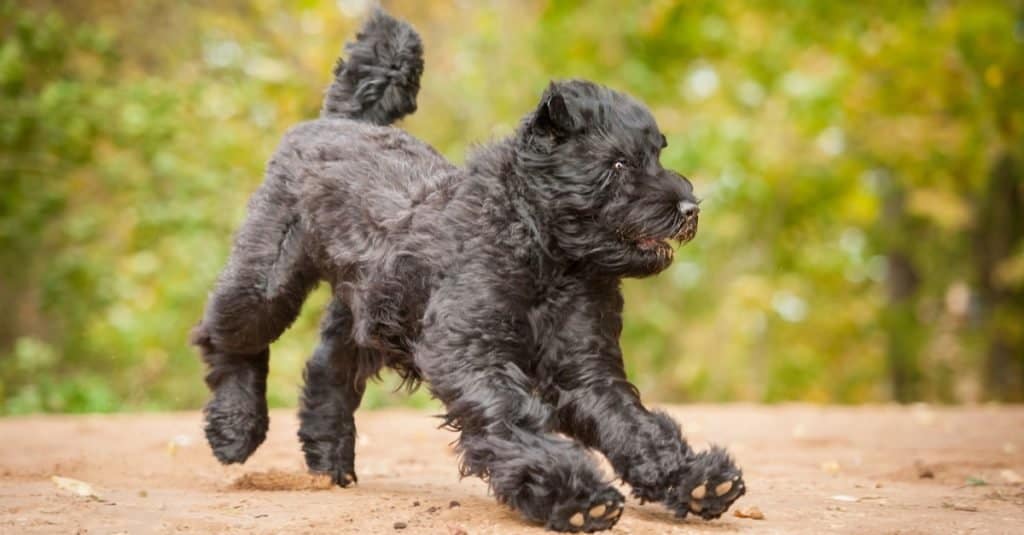
Black Russian Terriers are highly intelligent, confident guard dogs who need lots of daily exercise.
©Rita_Kochmarjova/Shutterstock.com
Puppies
Before bringing home a Black Russian Terrier puppy, make sure your home is ready for the new addition to your family. Puppy-proof your space by removing any potential hazards or harmful chemicals. Also, move anything out of the space that you wouldn’t want to see destroyed by a puppy.
You should also purchase food, a collar and leash, a dog bed, a crate, toys, and any other supplies that your dog will need. This will help ensure that you’re ready as soon as you bring them home.
It will be important to watch how much exercise your dog gets. By the time the puppy is three months old, you can start taking them for five-minute walks and slowly increase the length of these walks. Until a puppy is nine months old, it should not participate in any intense activities such as jumping, going upstairs, or running on firm surfaces. A puppy’s bones and joints are still developing, and these activities could lead to an injury.
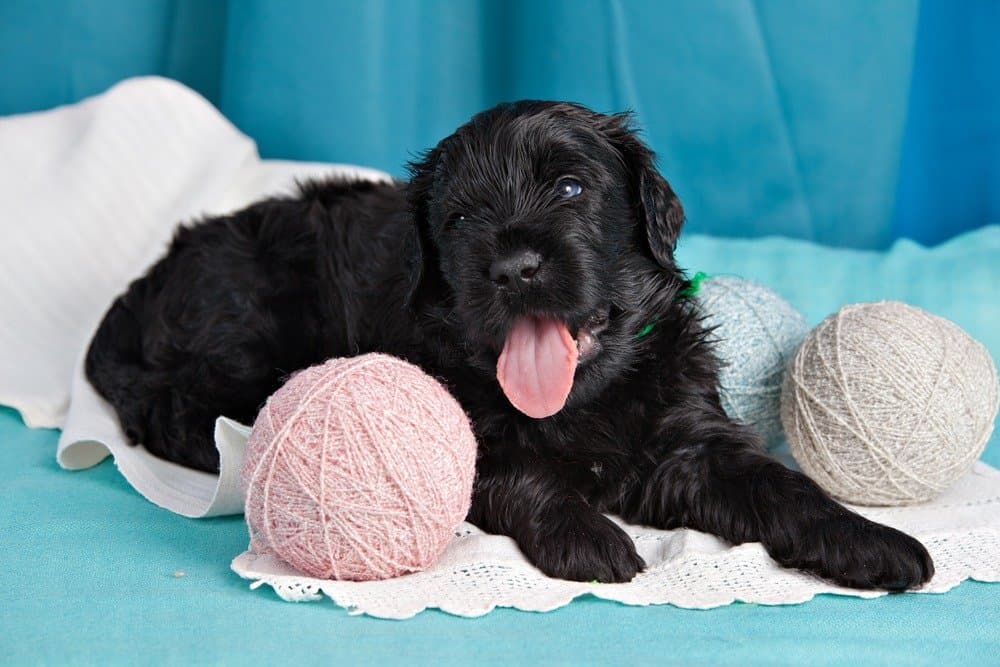
Puppies should not be heavily exercised while their bones are developing.
©Anna Tronova/Shutterstock.com
With Children
This dog can make an excellent dog for families with children. They can be both protective and playful. Even though they are large dogs, Blackies can be very gentle with children. If you have younger children in the house, you should always closely supervise them when they are around your Black Russian Terriers. A Black Russian Terrier is a large dog and could accidentally knock down a child as they play together.
If you are looking to adopt a Black Russian Terrier from a rescue organization, you will want to find out if it is tolerant of children. Blackies do best when they grow up alongside children, so an older dog that wasn’t raised around children may not be the best match for you.
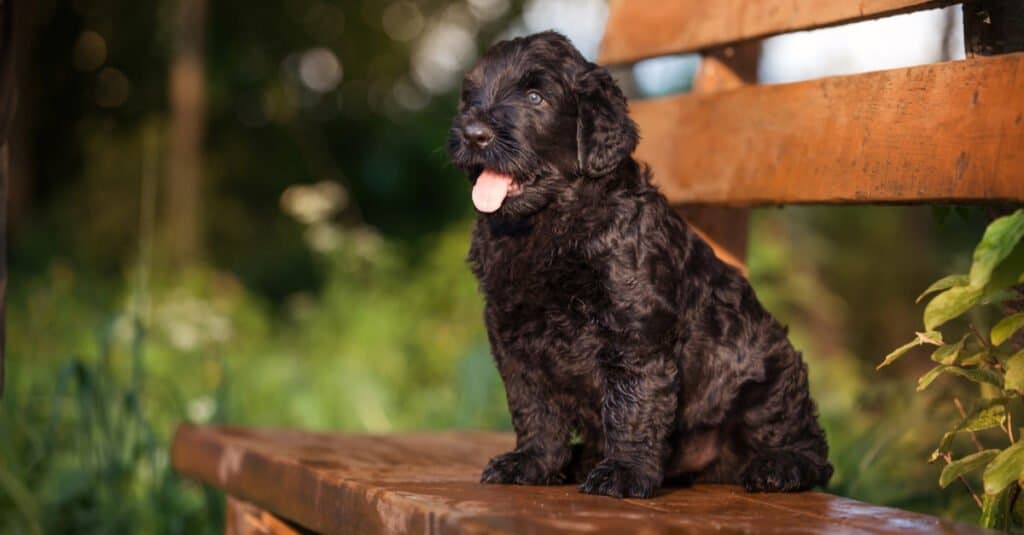
Black Russian Terriers are tolerant of children.
©Utekhina Anna/Shutterstock.com
Dogs similar to Black Russian Terriers
Giant Schnauzers, Rottweilers, and Airedale Terriers are three breeds similar to the Black Russian Terrier.
• Giant Schnauzer: The Giant Schnauzer was one of the breeds used to create the Black Russian Terrier. Both breeds are very territorial and can make excellent watch dogs. Blackies make a better family pet than Giant Schnauzers. They are also more tolerant of other dogs.
• Rottweiler: Rottweilers and Black Russian Terriers are both about the same size. Both breeds have an average weight right around 110 pounds. Rottweilers are easier to groom than Black Russian Terriers that will need to be brushed multiple times each week. Both breeds make good watchdogs, but a Rottweiler is more likely to bite than a Black Russian Terrier is.
• Airedale Terrier: Airedale Terriers and Black Russian Terriers are both very affectionate and social breeds. They are both good breeds to have around children. Black Russian Terriers are a much larger breed than Airedale Terriers, though. The average weight of a Black Russian Terrier is 111.5 pounds, while Airedale Terriers weigh just 57.5 pounds, on average.
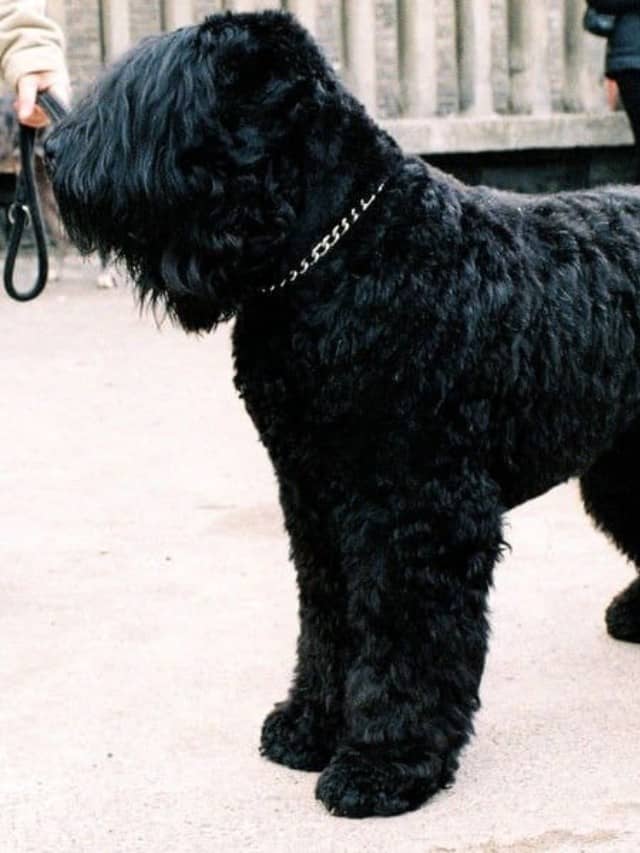
©Pleple2000 / CC BY-SA 3.0 – License
Popular Names
Looking for the right name for your new Black Russian Terrier? Here are a few ideas for you to consider:
- Max
- Scout
- Sully
- Cooper
- Barkley
- Olive
- Maggie
- Daisy
- Zoey
- Maisie
Black Russian Terrier FAQs (Frequently Asked Questions)
What is a Black Russian Terrier?
A Black Russian Terrier is a large black dog that was bred in the form USSR to work with the army. The breed is very intelligent and protective. They make an excellent guard dog, but are also good with kids and can make a good family dog.
How much does Black Russian Terrier cost to own?
A Black Russian Terrier will cost between $1,800 and $2,500 if purchased from a breeder. You may also be able to find Black Russian Terriers from a rescue organization. Adopting through a rescue organization will likely cost about $300 to cover application fees and vaccinations.
Before determining if you have the funds to adopt a Black Russian Terrier, you should also consider the other expenses associated with owning a dog. You will need to budget enough money to pay for veterinary expenses, training, food, toys, and supplies for your Black Russian Terrier. This will be more expensive your first year owning the Blackie, and you could easily spend over $1,000. For each of the following years that you own the dog, budget at least $500 to $1,000 for taking care of your pup.
Is Black Russian Terrier good with kids?
Yes, Black Russian Terriers are good with kids. They enjoy playing with kids and getting attention from them. Blackies know how to be gentle and can be quite tolerant. However, they are not the best pet for families with very young children that could be accidentally injured by these large dogs. Black Russian Terriers have a curly and rough coat, while a Giant Schnauzer’s coat is wirier. Giant Schnauzers are less tolerant around children than Black Russian Terriers.
How long does Black Russian Terrier live?
The average life expectancy of a Black Russian Terrier is between 10 and 12 years.
What is the difference between a Black Russian Terrier and a Giant Schnauzer?
Black Russian Terriers and Giant Schnauzers are both very large. Black Russian Terriers are larger, though, with an average weight of 111.5 pounds compared to the 82.5-pound average weight of a Giant Schnauzer.
Are Black Russian Terriers aggressive?
Most Black Russian Terriers are not aggressive, though they may be distrusting of strangers. However, if not properly trained and socialized, Black Russian Terriers may be aggressive.
Are Black Russian Terriers good family dogs?
Yes, Black Russian Terriers can make a good family pet. The breed enjoys playing with children, but also knows how to be gentle with them. Black Russian Terriers can be very protective of the ones they love. They enjoy spending lots of time with their family members. However, Black Russian Terriers may develop separation anxiety if they are alone for too long, so this isn’t the best breed for your family if someone isn’t home most of the time.
Are Black Russian Terriers hypoallergenic?
No, even though Black Russian Terriers are not a heavy shedding dog, they are not a hypoallergenic breed.
Are Black Russian Terriers herbivores, carnivores, or omnivores?
Black Russian Terriers are Omnivores, meaning they eat both plants and other animals.
What Kingdom do Black Russian Terriers belong to?
Black Russian Terriers belong to the Kingdom Animalia.
What class do Black Russian Terriers belong to?
Black Russian Terriers belong to the class Mammalia.
What phylum to Black Russian Terriers belong to?
Black Russian Terriers belong to the phylum Chordata.
What family do Black Russian Terriers belong to?
Black Russian Terriers belong to the family Canidae.
What order do Black Russian Terriers belong to?
Black Russian Terriers belong to the order Carnivora.
What genus do Black Russian Terriers belong to?
Black Russian Terriers belong to the genus Canis.
What type of covering do Black Russian Terriers have?
Black Russian Terriers are covered in Hair.
How many babies do Black Russian Terriers have?
The average number of babies a Black Russian Terrier has is 5.
What is an interesting fact about Black Russian Terriers?
Black Russian Terriers are confident, calm, and highly intelligent!
What is the scientific name for the Black Russian Terrier?
The scientific name for the Black Russian Terrier is Canis Lupus.
What is the difference between Black Russian Terriers and Giant Schnauzers?
The main differences between a Black Russian Terrier and a Giant Schnauzer include their size, coat, behavior, lifestyle, and health issues.
Thank you for reading! Have some feedback for us? Contact the AZ Animals editorial team.
Sources
- American Kennel Club, Available here: https://www.akc.org/dog-breeds/black-russian-terrier/
- Dog Time, Available here: https://dogtime.com/dog-breeds/black-russian-terrier#/slide/1
- Wikipedia, Available here: https://en.wikipedia.org/wiki/Black_Russian_Terrier
- Pet Finder, Available here: https://www.petfinder.com/dog-breeds/black-russian-terrier/
- Vet Street, Available here: http://www.vetstreet.com/dogs/black-russian-terrier#0_s04wfek8
- Zestava Kennel, Available here: https://www.zastavabrt.com/growth-chart
- Dog-Learn, Available here: https://www.dog-learn.com/dog-breeds/black-russian-terrier/care#:~:text=Black%20Russian%20Terrier%20Breed%20Development&text=And%20when%20do%20Black%20Russian,about%2012%20months%20of%20age.
- Dog Breeds 9-1-1, Available here: https://www.dogbreeds911.com/large-dog-breeds-black-russian-terrier.html
- Dogell, Available here: https://dogell.com/en/compare-dog-breeds/black-russian-terrier-vs-giant-schnauzer-vs-bouvier-des-flandres
- The Paws, Available here: https://www.thepaws.net/65-best-black-russian-terrier-dog-names/

